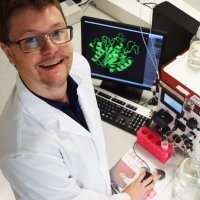Scientists reveal double life of sunflower enzyme

Scientists have explained how a protein-cutting enzyme can join the ends of proteins together, creating protein circles; a finding with immediate applications in producing therapeutic drug treatments that is published in a study in the open access journal eLife.
The common enzyme at the centre of the study is from the common sunflower and leads a double life – able to cut proteins, but also join them together. Previously, the process from cutting to joining was not understood.
Researchers from The University of Western Australia and the University of Minnesota have at last provided a structural explanation of how sunflowers make super-stable protein rings and by inference, how the many other plants with circular proteins do it too.
The team and others around the world had previously shown the enzyme could cut proteins, and also that a few could join them together sometimes.
By making a protein crystal of the enzyme, the UWA-led team was able to look at the protein's shape in three dimensions and also saw a little bit of protein caught in the enzyme's 'jaws' – what's called a tetrahedral intermediate. This information, combined with experiments introducing mutations into the protein, explained how the enzyme takes a protein string and creates a protein ring with it.
The work is of interest to chemists and biotechnologists especially due to the current interest in the circularisation process for its use in generating a host of circular protein scaffolds that could be used as therapeutic drug treatments.
The study shows the crystal structure of an active form of the enzyme known as AEP (asparaginyl endo-peptidase) from sunflower seeds. The authors directly addressed the question of how AEPs actually produced circular proteins.
Lead author Dr. Joel Haywood, a research associate in UWA's School of Molecular Sciences said AEP enzymes were found in all plants and their best-known job was to defend plants from pathogens and to mature seed store proteins, but it was thought that some had specialised to produce circular proteins that were super-stable and rigid.
"Most scientists think these protein rings protect plants from pests," Dr. Haywood said.
"We were lucky to notice a tetrahedral intermediate in the structure. They're very rare, but extremely helpful as it's like catching the enzyme in the act of cutting and joining."
UWA lab head Dr. Joshua Mylne said what surprised the researchers was that seemingly any AEP could circularise proteins provided the enzyme was 'activated' properly and was given the right protein and conditions to circularise.
"We showed this using a couple AEPs from plants lacking circular proteins altogether," Dr. Mylne said.
"Now we've worked out how to crystallise these enzymes and how they work, we're looking how to use bacteria to cheaply create highly efficient enzymes."
Dr. Mylne led the team of Australian and US scientists that revealed the enzyme process through the Australian Research Council-supported study "Structural basis of ribosomal peptide macrocyclisation in plants."
More information: Joel Haywood et al. Structural basis of ribosomal peptide macrocyclization in plants, eLife (2018). DOI: 10.7554/eLife.32955
Journal information: eLife
Provided by University of Western Australia




















